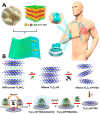Artificial Intelligence (AI) and Internet of Medical Things (IoMT) Assisted Biomedical Systems for Intelligent Healthcare
- PMID: 35892459
- PMCID: PMC9330886
- DOI: 10.3390/bios12080562
Artificial Intelligence (AI) and Internet of Medical Things (IoMT) Assisted Biomedical Systems for Intelligent Healthcare
Abstract
Artificial intelligence (AI) is a modern approach based on computer science that develops programs and algorithms to make devices intelligent and efficient for performing tasks that usually require skilled human intelligence. AI involves various subsets, including machine learning (ML), deep learning (DL), conventional neural networks, fuzzy logic, and speech recognition, with unique capabilities and functionalities that can improve the performances of modern medical sciences. Such intelligent systems simplify human intervention in clinical diagnosis, medical imaging, and decision-making ability. In the same era, the Internet of Medical Things (IoMT) emerges as a next-generation bio-analytical tool that combines network-linked biomedical devices with a software application for advancing human health. In this review, we discuss the importance of AI in improving the capabilities of IoMT and point-of-care (POC) devices used in advanced healthcare sectors such as cardiac measurement, cancer diagnosis, and diabetes management. The role of AI in supporting advanced robotic surgeries developed for advanced biomedical applications is also discussed in this article. The position and importance of AI in improving the functionality, detection accuracy, decision-making ability of IoMT devices, and evaluation of associated risks assessment is discussed carefully and critically in this review. This review also encompasses the technological and engineering challenges and prospects for AI-based cloud-integrated personalized IoMT devices for designing efficient POC biomedical systems suitable for next-generation intelligent healthcare.
Keywords: Internet of Medical Things; artificial intelligence; healthcare; point-of-care sensors; smart sensors; wearable devices.
Conflict of interest statement
Authors declare no conflict of interest.
Figures













References
-
- Sekar M., Sriramprabha R., Sekhar P.K., Bhansali S., Ponpandian N., Pandiaraj M., Viswanathan C. Towards wearable sensor platforms for the electrochemical detection of cortisol. J. Electrochem. Soc. 2020;167:67508. doi: 10.1149/1945-7111/ab7e24. - DOI
-
- Kaur D., Uslu S., Rittichier K.J., Durresi A. Trustworthy artificial intelligence: A review. ACM Comput. Surv. 2022;55:1–38. doi: 10.1145/3491209. - DOI
-
- Hebb D.O. The Organization of Behavior: A Neuropsychological Theory. John Wiley and Sons, Inc.; New York, NY, USA: 1949. p. 335. - DOI
Publication types
MeSH terms
LinkOut - more resources
Full Text Sources

